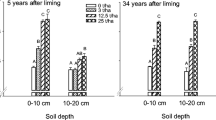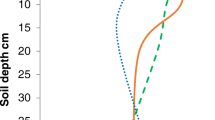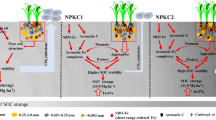Abstract
Soil texture, coupled with environmental factors, plays an important role in soil nutrient conservation. In order to evaluate the effect of soil texture on soil fertility of fluvo-aquic soil, a long-term experiment that included four fluvo-aquic soils with different textures (sand, sandy loam, sandy clay loam and loamy clay) was established in 1990. In 2017, soil samples were collected from the 0–20 cm depth to measure soil organic carbon (SOC), total nitrogen (TN), total phosphorus (TP), total potassium (TK), alkali-hydrolysable nitrogen (AN), available phosphorus (AP) and available potassium (AK) concentrations, water-stable aggregate distribution, and aggregate-associated carbon and nitrogen. After 27 years of the experiment, the sand content decreased and the silt and clay content increased in sand and sandy loam, while the sand content increased and the silt content decreased in loamy clay. The SOC, total and available N, P and K (except TK) increased more in coarse-textured soils than in finely textured soils, while the concentrations of SOC, TN, TP, AN and AK increased significantly with a decrease in the sand content. The SOC, TN, AN and AK concentrations in loamy clay were 2 to 3 times higher than those in the sand treatment. The mass percentage of each aggregate fraction, especially the content of macroaggregates, increased significantly with a decrease in the sand content. Soil aggregates play an important role in SOC and TN storage. 75–84% of SOC and 67–81% of TN were stored in macroaggregates and microaggregates. It was concluded that soil particle composition was affected by long-term cultivation. The finely textured soils had higher SOC, TN and TP storage capacity and provided more AN and AK. The formation and stability of aggregate structures were limited by the high content of sand particles, which led to a negative influence on the storage and supply of SOC and N in the fluvo-aquic soils.




Similar content being viewed by others
REFERENCES
M. A. Araujo, Y. L. Zinn, and R. Lal, “Soil parent material, texture and oxide contents have little effect on soil organic carbon retention in tropical highlands,” Geoderma 300, 1–10 (2017). https://doi.org/10.1016/j.geoderma.2017.04.006
E. M. Bach, S. G. Baer, C. K. Meyer, and J. Six, “Soil texture affects soil microbial and structural recovery during grassland restoration,” Soil Biol. Biochem. 42 (12), 2182–2191 (2010). https://doi.org/10.1016/j.soilbio.2010.08.014
M. A. Baquy, M. J. Abedin Mian, and A. Z. M. Moslehuddin, “Fertilizer management effects on physical properties of soil under rice cultivation,” Bangladesh J. Environ. Sci. 24, 202–208 (2013).
M. J. Castellano, J. P. Kaye, H. Lin, and J. P. Schmidt, “Linking carbon saturation concepts to nitrogen saturation and retention,” Ecosystems 15 (2), 175–187 (2012). https://doi.org/10.1007/s10021-011-9501-3
A. Eleftheriadis, F. Lafuente, and M. B. Turrión, “Effect of land use, time since deforestation and management on organic C and N in soil textural fractions,” Soil Tillage Res. 183, 1–7 (2018). https://doi.org/10.1016/j.still.2018.05.012
E. T. Elliott, “Aggregate structure and carbon, nitrogen, and phosphorus in native and cultivated soil,” Soil Sci. Soc. Am. J. 50 (3), 627–633 (1986). https://doi.org/10.2136/sssaj1986.03615995005000030017x
E. T. Elliott, C. A. Palm, D. E. Reuss, and C. A. Monz, “Organic matter contained in soil aggregates from a tropical chronosequence: correction for sand and light fraction,” Agric. Ecosyst. Environ. 34 (1–4), 443–451 (1991). https://doi.org/10.1016/0167-8809(91)90127-J
N. N. Ge, X. R. Wei, X. Wang, X. T. Liu, M. A. Shao, X. X. Jia, X. Z. Li, and Q. Y. Zhang, “Soil texture determines the distribution of aggregate-associated carbon, nitrogen and phosphorous under two contrasting land use types in the Loess Plateau,” Catena 172, 148–157 (2019). https://doi.org/10.1016/j.catena.2018.08.021
R. M. Gentile, B. Vanlauwe, and J. Six, “Integrated soil fertility management: aggregate carbon and nitrogen stabilization in differently textured tropical soils,” Soil Biol. Biochem. 67, 124–132 (2013). https://doi.org/10.1016/j.soilbio.2013.08.016
N. Ghorbani, F. Raiesi, and S. Ghorbani, “Bulk soil and particle size-associated C and N under grazed and ungrazed regimes in mountainous arid and semi-arid rangelands,” Nutr. Cycle Agroecosyst. 93, 15–34 (2012). https://doi.org/10.1007/s10705-012-9496-y
A. Golestanifard, J. Santner, A. Aryan, H. P. Kaul, and W. W. Wenzel, “Potassium fixation in northern Iranian paddy soils,” Geoderma 375, 114475 (2020). https://doi.org/10.1016/j.geoderma.2020.114475
W. Gong, X. Y. Yan, Z. C. Cai, J. Y. Wang, T. X. Hu, and Y. B. Guan, “Effects of long-term fertilization on soil physical properties and erosion-resistance under wheat-maize rotation system in North China Plain,” Acta Pedol. Sin. 46 (3), 520–525 (2009).
J. Hassink, “The capacity of soils to preserve organic C and N by their association with clay and silt particles,” Plant Soil 191 (1), 77–87 (1997).
F. Hosseini, M. R. Mosaddeghi, M. A. Hajabbasi, and A. I. Mamedov, “Effects of endophyte-infected and non-infected tall fescue residues on aggregate stability in four texturally different soils,” Geoderma 285, 195–205 (2017). https://doi.org/10.1016/j.geoderma.2016.10.001
Soil Physical and Chemical Analysis (Shanghai Science and Technology Press, Shanghai, 1983) [in Chinese].
R. K. Lu, Analytical Methods for Soil and Agro-Chemistry (China Agricultural Science and Technology Press, Beijing, 2000) [in Chinese].
F. J. Matus, C. H. Lusk, and C. R. Maire, “Effects of soil texture, carbon input rates, and litter quality on free organic matter and nitrogen mineralization in Chilean rain forest and agricultural soils,” Commun. Soil Sci. Plant Anal. 39 (1–2), 187–201 (2008). https://doi.org/10.1080/00103620701759137
K. K. Mclauchlan, “Effects of soil texture on soil carbon and nitrogen dynamics after cessation of agriculture,” Geoderma 136 (1–2), 289–299 (2006). https://doi.org/10.1016/j.geoderma.2006.03.053
A. Mohammad, “Assessing changes in soil microbial population with some soil physical and chemical properties,” Int. J. Plant, Anim. Environ. Sci. 5, 117–123 (2015).
E. K. Muema, G. Cadisch, and F. Rasche, “Soil texture modulates the response of ammonia-oxidizing prokaryotes to biochemical quality of organic inputs in tropical agricultural soils,” Soil Biol. Biochem. 100, 218–228 (2016). https://doi.org/10.1016/j.soilbio.2016.06.027
A. F. Plante, R. T. Conant, C. E. Stewart, K. Paustian, J. Six, “Impact of soil texture on the distribution of soil organic matter in physical and chemical fractions,” Soil Sci. Soc. Am. J. 70, 287–296 (2006). https://doi.org/10.2136/sssaj2004.0363
F. Rakhsh, A. Golchin, A. B. A. Agha, and P. N. Nelson, “Mineralization of organic carbon and formation of microbial biomass in soil: effects of clay content and composition and the mechanisms involved,” Soil Biol. Biochem. 151, 108036 (2020). https://doi.org/10.1016/j.soilbio.2020.108036
I. C. Regelink, C. R. Stoof, S. Rousseva, L. P. Weng, G. J. Lair, P. Kram, N. P. Nikolaidis, M. Kercheva, S. Banwart, and R. N. J. Comans, “Linkages between aggregate formation, porosity and soil chemical properties,” Geoderma 247–248, 24–37 (2015). https://doi.org/10.1016/j.geoderma.2015.01.022
J. R. Sarker, B. P. Singh, A. L. Cowie, Y. Y. Fang, D. Collins, W. Badgery, and R. C. Dalal, “Agricultural management practices impacted carbon and nutrient concentrations in soil aggregates, with minimal influence on aggregate stability and total carbon and nutrient stocks in contrasting soils,” Soil Tillage Res. 178, 209–223 (2018). https://doi.org/10.1016/j.still.2017.12.019
N. A. Scott, C. V. Cole, E. T. Elliott, and S. A. Huffman, “Soil textural control on decomposition and soil organic matter dynamics,” Soil Sci. Soc. Am. J. 60 (4), 1102–1109 (1996). https://doi.org/10.2136/sssaj1996.03615995006000040020x
M. Singh, B. Sarkar, B. Biswas, N. S. Bolan, and G. J. Churchman, “Relationship between soil clay mineralogy and carbon protection capacity as influenced by temperature and moisture,” Soil Biol. Biochem. 109, 95–106 (2017). https://doi.org/10.1016/j.soilbio.2017.02.003
J. Six, R. T. Conant, E. A. Paul, and K. Paustian, “Stabilization mechanisms of soil organic matter: Implications for C-saturation of soils,” Plant Soil 241 (2), 155–176 (2002). https://doi.org/10.1023/A:1016125726789
S. Sugihara, S. Funakawa, M. Kilasara, and T. Kosaki, “Effect of land management and soil texture on seasonal variations in soil microbial biomass in dry tropical agroecosystems in Tanzania,” Appl. Soil Ecol. 44 (1), 80–88 (2010). https://doi.org/10.1016/j.apsoil.2009.10.003
M. Z. Tan, K. L. Li, X. Z. Shi, B. Z. Zhao, and J. Chen, “Impact of soil profile texture pattern (SPTP) on wheat yield in North China Plain,” Soils 46 (5), 913–919 (2014).
M.Z. Tan, S. X. Mi, K. L. Li, X. Z. Shi, and J. Chen, “Application of fuzzy set theory to soil profile texture configuration: a case study of soils in the soils in the alluvial plain of Fengqiu county,” Acta Pedol. Sin. 48 (2), 221–229 (2011).
J. M. Tisdall and J. M. Oades, “Organic matter and water-stable aggregates in soils,” Eur. J. Soil Sci. 33 (2), 141–163 (1982). https://doi.org/10.1111/j.1365-2389.1982.tb01755.x
R. Tripathi, A. K. Nayak, P. Bhattacharyya, A. K. Shukla, M. Shahid, R. Raja, B. B. Panda, S. Mohanty, A. Kumar, and V. K. Thilagam, “Soil aggregation and distribution of carbon and nitrogen in different fractions after 41 years long-term fertilizer experiment in tropical rice–rice system,” Geoderma 213, 280–286 (2014). https://doi.org/10.1016/j.geoderma.2013.08.031
Y. Wang, J. H. Zhang, and Z. H. Zhang, “Influences of intensive tillage on water-stable aggregate distribution on a steep hillslope,” Soil Tillage Res. 151, 82–92 (2015). https://doi.org/10.1016/j.still.2015.03.003
A. Yan, Z. J. Li, H. Q. Wu, and P. F. Wen, “Effect of cultivation years on vertical distribution of soil texture and organic carbon,” J. Soil Water Conserv. 31 (1), 291–295 (2017).
X. F. Zhang, A. N. Zhu, X. L. Xin, W. L. Yang, J. B. Zhang, and S. J. Ding, “Tillage and residue management for long-term wheat-maize cropping in the North China Plain: I. Crop yield and integrated soil fertility index,” Field Crop Res. 221, 157–165 (2018). https://doi.org/10.1007/s11368-017-1809-y
X. F. Zhang, X. L. Xin, A. N. Zhu, J. B. Zhang, and W. L. Yang, “Effects of tillage and residue managements on organic C accumulation and soil aggregation in a sandy loam soil of the North China Plain,” Catena 156, 176–183 (2017). https://doi.org/10.1016/j.catena.2017.04.012
Y. H. Zhang, S. M. Shao, D. D. Guo, S. Q. Zhang, X. Song, K. Yue, K. K. Zhang, and D. J. Bao, “Phosphorus adsorption and desorption characteristics of different textural fluvo-aquic soils under long-term fertilization,” J. Soils Sediments 19 (3), 1306–1318 (2019). https://doi.org/10.1007/s11368-018-2122-0
Y. L. Zinn, R. Lal, J. M. Bigham, and D. V. S. Resck, “Edaphic controls on soil organic carbon retention in the Brazilian Cerrado: texture and mineralogy,” Soil Sci. Soc. Am. J. 71 (4), 1204–1214 (2007). https://doi.org/10.2136/sssaj2006.0014
Funding
This work was financially supported by the National Key Research and Development Program of China (Grant nos. 2016YFD0200304 and 2018YFD0200601), the National Natural Science Foundation of China (Grant no. 41877023), the Jiangsu Agriculture Science and Technology Innovation Fund (Grant no. CX (20) 2003), Natural Science Foundation of Jiangsu Province (Grant no. BK20191509).
Author information
Authors and Affiliations
Corresponding authors
Ethics declarations
The authors declare that they have no conflicts of interest.
Supplementary Information
Rights and permissions
About this article
Cite this article
Ding, S.J., Zhang, X.F., Yang, W.L. et al. Soil Nutrients and Aggregate Composition of Four Soils with Contrasting Textures in a Long-Term Experiment. Eurasian Soil Sc. 54, 1746–1755 (2021). https://doi.org/10.1134/S1064229321110041
Received:
Revised:
Accepted:
Published:
Issue Date:
DOI: https://doi.org/10.1134/S1064229321110041




